A desiccant dryer takes water out of compressed air. This helps keep the air clean in factories. Water in air systems can cause many problems. It can make rust and scale form. Bacteria can grow, and machines can lose their oil. These problems can break parts and stop machines from working. They also make the system work less well. Factories that need dry air use desiccant dryers. This helps them avoid these problems and protect important machines.
Common problems from water in air systems are:
要点
Desiccant dryers take water out of compressed air. This helps protect machines and keeps air clean in factories. They use special materials called desiccants that catch water. The dryers have two towers that switch jobs to dry air all the time. Desiccant dryers make air much drier than refrigerated dryers. This makes them great for food, electronics, and paint shops. There are different types of desiccant dryers. They use different ways to dry and reuse desiccants. This helps save energy and keeps them working well. You need to do regular maintenance, like changing filters and desiccant. This helps the dryer work right and stops expensive machine damage.
What Is a Desiccant Dryer
A desiccant dryer is a device that removes moisture from compressed air or gas using desiccant materials. These materials absorb water vapor, ensuring the air or gas is dry and suitable for sensitive applications.
Desiccant Air Dryer Basics
A desiccant air dryer is a machine that takes water out of compressed air. It uses special materials called desiccants, like silica gel or activated alumina, to catch and hold water. Most desiccant dryers have two towers filled with desiccant beads. One tower dries the air while the other gets rid of the water it collected. This step is called regeneration. The system switches between the towers so it can keep drying air all the time.
The main parts of a desiccant air dryer work together in a cycle. First, wet air goes into the system. Pre-filters clean the air by taking out dirt and oil. Then, the air moves into one tower, where the desiccant grabs the water. When the desiccant is full, the system switches to the second tower. The first tower then dries out the desiccant using dry or heated air. Automatic controls help switch the towers and keep everything working right. Dew point monitors check if the air is dry enough and help control the system.
ヒント Dew point monitors make sure the air stays dry for sensitive equipment.
Desiccant dryers can use different ways to dry out the desiccant. Some use dry compressed air, some use heat, and others use a blower to push air through the tower. Each way changes how much energy the dryer uses and how well it works.
Why Use Desiccant Dryers
Industries pick desiccant dryers when they need very dry compressed air. These dryers can reach dew points as low as -100°F (-73°C). This means the air has almost no water left. Refrigerated dryers only reach dew points above 3°C. The table below shows the difference:
ドライヤータイプ | Typical Dew Point Range |
|---|---|
Refrigerated Dryer | +3°C to +10°C |
乾燥機 | -20°C to -70°C (as low as -73°C / -100°F) |
Desiccant dryers are important where even a little water can cause problems. Industries like pharmaceuticals, food and beverage, electronics, and car paint shops use these dryers to protect their products and machines. In medicine and food factories, dry air stops bacteria and mold from growing. In electronics, it stops rust and helps parts last longer. Paint shops use dry air to stop problems in painted surfaces.
Desiccant dryers help:
Keep equipment from breaking because of water.
Make sure products stay clean and safe.
Meet strict rules for air quality.
Lower repair costs by stopping breakdowns.
Desiccant dryers also help factories save money over time. They protect machines, cut down on downtime, and keep products high quality. Some new models use less energy and have dew point alarms to warn if air is not dry enough. Regular care, like changing filters and replacing desiccant, keeps the system working well and stops expensive repairs.
注: Picking the right desiccant dryer and taking care of it helps factories run well and protects both equipment and products.
How Desiccant Dryers Work
Desiccant dryers work by adsorbing moisture from the air, using desiccant materials like silica gel or activated alumina. These materials attract and hold water molecules, ensuring dry air output.
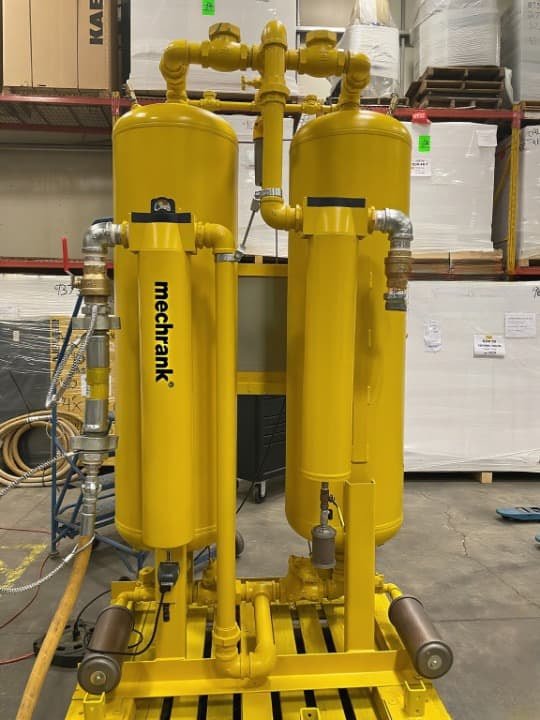
Adsorption and Regeneration
Desiccant dryers take water out of air by using adsorption. In this step, water vapor sticks to small beads inside the dryer. These beads are called desiccants. The drying process happens in cycles so the air stays dry.
乾燥させる: Wet compressed air goes into one tower. The desiccant beads inside grab and hold the water. The air that comes out is now very dry.
Regeneration: While one tower dries air, the other gets ready for the next round. Dry or heated air moves through the second tower. This air takes water out of the desiccant beads so they can be used again.
Re-pressurization: The tower that just finished regeneration is closed. It is brought back up to the same pressure as the rest of the system.
Cycle Switch: The two towers switch jobs. The tower with fresh desiccant starts drying air. The other tower begins regeneration.
This cycle lets desiccant dryers keep working all the time. It also helps the desiccant beads last longer.
について drying process uses energy. Heatless dryers use about 15-20% of their air for regeneration. Heated dryers use less air but need extra energy for heat. The chart below shows how much air each type uses for regeneration:
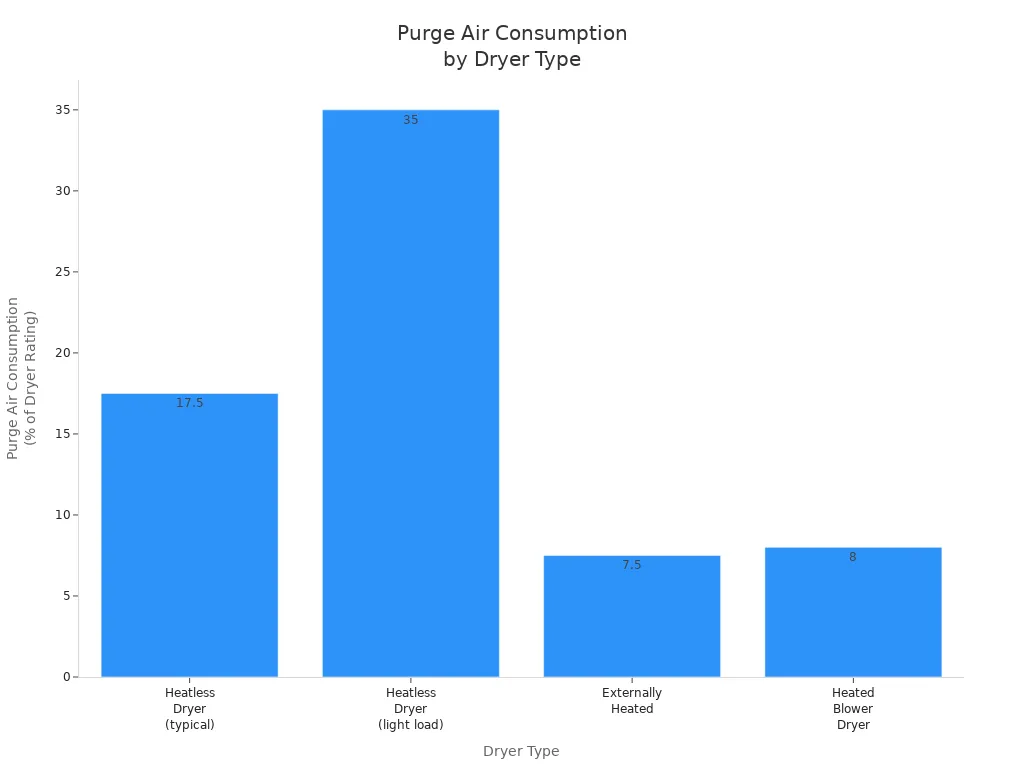
ドライヤータイプ | Purge Air Consumption (% of Dryer Rating) | Cycle Duration | Notes on Energy Use and Operation |
|---|---|---|---|
Heatless Dryer | 15-20% (typical), 30-40% (light load) | ~10 minutes | Uses dried compressed air for regeneration; purge air consumption increases under light load, reducing compressor capacity. |
Externally Heated | ~7.5% | ~4 hours | Uses electrically heated compressed air for regeneration; lower purge air consumption, reducing electrical costs. |
Heated Blower Dryer | Cooling purge averages ~8% (over cycle) | ~4 hours | Uses blower-heated ambient air, no compressed air for regeneration; cooling purge flow needed to remove heat from desiccant. |
Industrial desiccant dryers can save energy with better controls and monitoring. If the system runs too long or uses too much air, it wastes energy. Good care and smart controls help the system work better.
Desiccant Materials
Desiccant dryers use different materials to trap water. Each type works best for certain jobs. The most common desiccant materials are silica gel, molecular sieves, activated alumina, and calcium sulfate.
Desiccant Material | Moisture Adsorption Capacity / Characteristics | Typical Applications / Notes |
|---|---|---|
Silica Gel | Adsorbs about 40% of its weight in water; effective below 25°C (77°F) | Widely used in packaging, non-toxic, food and drug approved |
Molecular Sieves | Internal surface area of 700-800 m²; precise moisture control | Preferred for very low moisture needs, e.g., semiconductor manufacturing; stable at high temperatures and pressures |
Activated Alumina | Extensive surface area; high thermal stability | Suitable for harsh environments and sensitive, high-cost operations |
Calcium Sulfate | Reliable drying performance; environmentally compatible | Used in industrial dryers with sustainability focus |
Silica gel works well at lower temperatures and is safe for food and medicine. Molecular sieves have tiny holes that trap water very well. They are best for jobs that need very dry air, like electronics factories. Activated alumina is strong and can handle high heat. Calcium sulfate is good for the environment and works in green factories.
How long desiccant materials last depends on the type and how they are used. Silica gel can be used again after drying, but it may get weaker over time. Molecular sieves last longer but cost more. Activated alumina and calcium sulfate also last a long time if used right. Most desiccant materials do not need to be replaced often, which saves money.
Tip: Picking the right desiccant material helps the dryer work better and last longer.
Desiccant dryers need the right material and a good cycle to keep air dry and protect machines. When people ask, “how do desiccant dryers work,” they should look at both the adsorption and regeneration steps and the choice of desiccant material. This mix makes the drying process work well for many industries.
What Are the Different Types of Desiccant Air Dryers?
Desiccant air dryers come in several types, including heatless, heated, and blower purge systems. Each type uses desiccant materials to adsorb moisture from compressed air, ensuring dry and contaminant-free output.
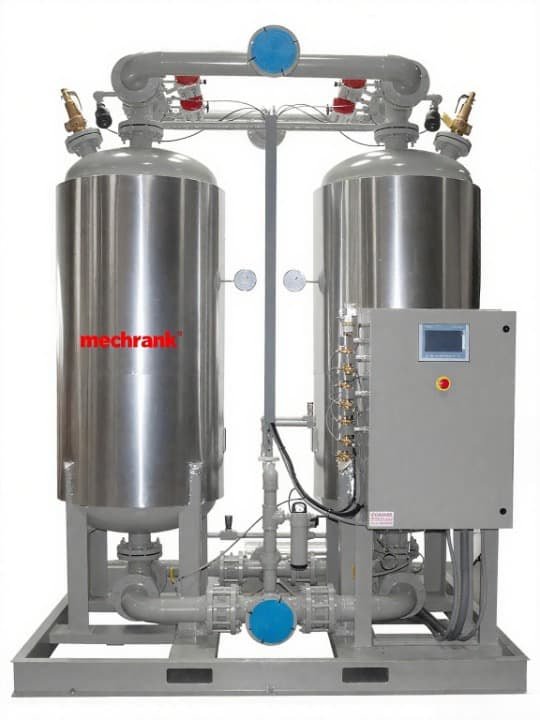
Heatless Desiccant Dryer
A heatless desiccant dryer takes water out of compressed air by adsorption. It uses special beads that pull in water. The dryer has two chambers. One chamber dries the air. The other chamber gets the beads ready to use again. The system switches chambers every few minutes. This type does not use outside heat. It uses the heat made when water sticks to the beads. Some dry air is used to clean the beads in the other chamber. This keeps the dryer simple and easy to take care of.
Key features of heatless desiccant dryers:
Drying cycles are short, about 10 minutes.
No outside heat is needed for regeneration.
用途 15-20% of dry air to clean beads.
Strong, tiny beads pull in water with physical forces.
Safety valves keep the chambers safe.
Heatless models are good where there is no heat or where simple use is needed.
Heated Desiccant Dryer
Heated desiccant dryers use outside heat, like electricity or steam, to get the beads ready again. This means they need less dry air for cleaning. These dryers are best for big factories that need very dry air. They cost more at first and have more parts. But they save money later because they use less compressed air.
アスペクト | Heated Desiccant Dryers | Heatless Desiccant Dryers |
|---|---|---|
Regeneration Method | Uses external heat | Uses dried compressed air |
Purge Air Use | 低い | High (15-20%) |
エネルギー使用 | Higher (for heating) | Lower (no external heat) |
初期費用 | より高い | より低い |
メンテナンス | More complex | Simpler |
ベストユース | Large, critical applications | Small or simple operations |
Heated dryers work better for big jobs but need more care and cost more.
Blower Purge Dryer
Blower purge dryers use a blower to push hot outside air through the beads. This way, they do not use compressed air to get the beads ready again. The system saves energy by using air from outside. These dryers are used in big plants where saving energy is important.
ドライヤータイプ | Energy Use (% of compressor power) | Energy Source | Key Feature |
|---|---|---|---|
Traditional Heated Purge | Electric, compressed | Uses heated compressed air for regeneration | |
Heated Blower Purge | 11% to 18.5% | Electric, blower | Uses heated ambient air, saves compressed air |
Blower purge dryers help lower costs and make big systems work better.
Regenerative Desiccant Air Dryer
A regenerative desiccant air dryer has two towers. One tower dries the air. The other tower gets the beads ready again. The system switches between towers to keep working. These dryers can make air very dry, so they are good for sensitive jobs. You need to check filters, change beads every three years, and clean valves. Taking care of the dryer helps it work well and keeps machines safe.
Tip: Always check pressure, temperature, and filters to keep the system working well.
Regenerative dryers cost more to run than refrigerated dryers, but they remove more water and work better in hard jobs.
What Are the Applications of Industrial Air Dryers?
Industrial air dryers are crucial in various sectors, including manufacturing, food processing, and pharmaceuticals, where removing moisture from compressed air is essential for product quality and operational efficiency.
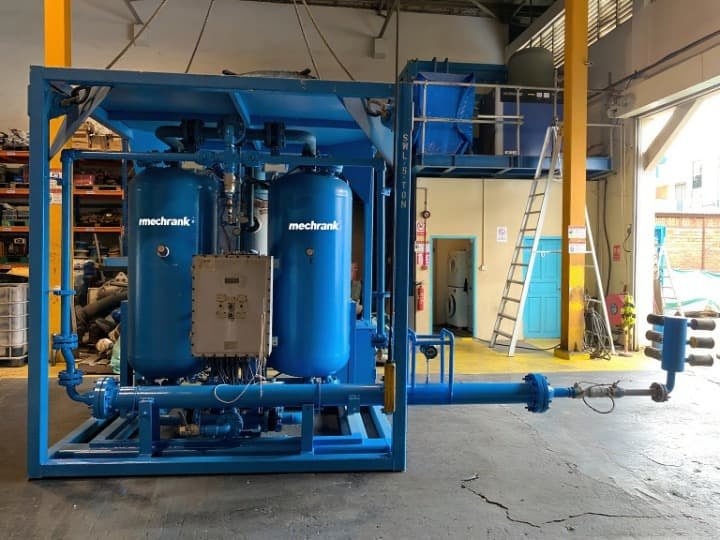
主要産業
Many industries need an industrial air dryer to work safely. These dryers take water out of compressed air. This helps protect products and machines from damage. Here are some industries that use desiccant dryers the most:
Manufacturing, like car plants, uses them to keep paint and parts dry.
Pharmaceutical companies need clean, dry air for hygiene rules.
Food and drink factories use them to stop bacteria and mold.
Chemical plants need dry air for safe reactions and good products.
Textile and packaging companies use them to protect materials.
Electronics factories need very dry air for sensitive parts.
These industries pick desiccant dryers for high-quality dry air. They must follow strict air rules and need careful control. Many also have tough rules to save energy and cut pollution. As factories use more robots, they need cleaner air. Desiccant dryers cost more at first, but they give very dry air and work well.
💡 New technology makes industrial air dryers use less energy and work better. This helps more industries use them.
Air Quality Standards
Strict air rules tell factories how to use desiccant dryers. These rules set limits for water, oil, and dirt in the air. The tables below show some important rules and what they mean:
スタンダード | Requirement | What This Means for Desiccant Dryers |
|---|---|---|
ISA 7.0.0.01-1996 | Dew point must be 18°F lower than the coldest system part, max 35°F; dirt must be less than 3 microns; oil less than 1 ppm | Desiccant dryers with special filters are needed to meet these tough rules, often matching ISO 8573.1:2010 class 2.3.3 |
Facility Air Quality Strategy | Use refrigerated dryers for normal air; use desiccant dryers for sensitive or outdoor air | Desiccant dryers are needed for very dry air, especially in cold or special places |
Standard/Regulation | Requirement | Why Desiccant Dryers Are Used |
|---|---|---|
ISO 8573-1 Quality Class 2 | Dew points as low as -40°F (-40°C) for very dry air | Desiccant dryers reach these low dew points, which is needed for the rule |
FDA | Air touching food must not have bad stuff in it | Desiccant dryers give dry, clean air to meet FDA rules |
USDA | Needs very clean air in food plants, especially meat and chicken | Desiccant dryers help keep air dry to stop germs and rust |
HACCP | Must control risks like dirty air and show proof | Desiccant dryers keep air dry, which helps stop contamination |
Following these rules helps factories keep products safe and machines working. An industrial air dryer is important for reaching the low dew points and clean air these rules need.
How Do You Choose the Right Desiccant Air Dryer?
Choosing the right desiccant air dryer involves considering factors such as air flow, operating pressure, and dew point requirements. Prioritize units that match your system’s specifications and environmental needs for optimal performance.
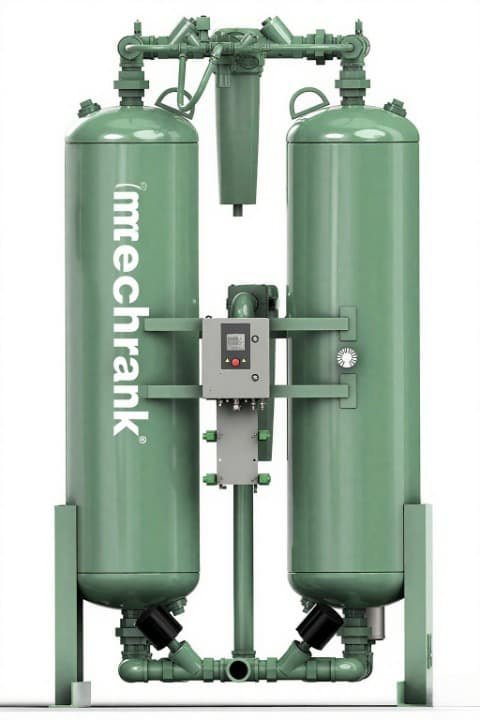
Selection Factors
Picking the right desiccant dryer depends on a few things. First, you must know how dry the air should be. Some jobs need very dry air, like in cold places where other dryers do not work. The size and pressure of the air system are also important. Bigger systems need dryers that can handle more air.
Other things to think about are:
Which type of desiccant dryer to use: heatless, heated, or blower purge
How much energy it uses and what it costs to run
How often you need to do maintenance, like changing filters or desiccant
について table below shows how different dryers compare:
ドライヤータイプ | Capacity (SCFM) | Dew Point (°F) | Purge/Energy Use | Best For |
|---|---|---|---|---|
Heatless | 5 – 5000 | -40 to -100 | ~15% purge air | Simple, reliable applications |
Heated | 500 – 5000 | -40 to -100 | ~7% purge air + electric heating | Large, cost-focused facilities |
Blower Purge | 750 – 5000 | 0 to -40 | Blower motor, no purge air | High volume, energy savings |
Tip: Always pick a dryer that fits your system and where you use it.
メンテナンスのヒント
Taking care of a desiccant dryer helps it last longer. You should put pre-filters in to stop dirt and oil from getting inside. Check dew point sensors often to find water problems early. Change the desiccant when the maker says so, or it will not dry air well.
Maintenance steps are:
Watch for drops in pressure or wet spots.
Change desiccant beds when needed.
Clean and check valves, drains, and mufflers.
Calibrate dew point sensors once a year.
Doing regular maintenance stops breakdowns and keeps the air clean.
Latest Innovations
New desiccant dryers save energy and are easier to use. Many now have two towers that give dry air all the time. Some have smart controls that change drying cycles using dew point readings. This helps save energy and makes the dryer work better.
Other new features are:
Built-in filters and better water removal
These new ideas help factories save money, have less downtime, and meet tough air rules.
Desiccant dryers help keep air dry and safe in factories. People need to pick the right dew point, flow rate, and pressure for their needs. Doing regular care, like changing desiccant and checking filters, keeps the system working well.
Some good things are that they dry air all the time, make products better, and can save energy.
Some problems are that they use energy and need care.
Learning about new technology and good ways to use dryers helps people get the best results from their air drying systems.
よくあるご質問
What is the main job of a desiccant dryer?
A desiccant dryer removes water from compressed air. It uses special beads to trap moisture. This keeps machines safe and helps products stay clean.
How often should someone replace the desiccant material?
Most desiccant materials last about three years. The exact time depends on how much air passes through the dryer and the type of desiccant used.
Can a desiccant dryer work in cold weather?
Yes, a desiccant dryer works well in cold places. It can reach very low dew points. This stops water from freezing in air lines.
Is desiccant dryer rental a good choice for short projects?
Many companies choose desiccant dryer rental for short-term needs. Renting helps save money and gives access to the right size dryer without a big purchase.
What happens if someone skips maintenance on a desiccant dryer?
If maintenance is skipped, the dryer may not remove water well. Machines can get damaged, and air quality drops. Regular care keeps the system working right.

